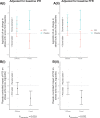Placebo-Controlled Efficacy of Percutaneous Coronary Intervention for Focal and Diffuse Patterns of Stable Coronary Artery Disease
- PMID: 34340523
- PMCID: PMC8366766
- DOI: 10.1161/CIRCINTERVENTIONS.120.009891
Placebo-Controlled Efficacy of Percutaneous Coronary Intervention for Focal and Diffuse Patterns of Stable Coronary Artery Disease
Abstract
[Figure: see text].
Trial registration: ClinicalTrials.gov NCT02062593.
Keywords: angina pectoris; coronary artery disease; hemodynamics; ischemia; percutaneous coronary intervention.
Conflict of interest statement
For Sources of Funding and Disclosures, see page 817.
Figures



Comment in
-
Is There a Difference in Efficacy of Percutaneous Coronary Intervention for Focal and Diffuse Stable Coronary Artery Disease?Circ Cardiovasc Interv. 2021 Aug;14(8):e011013. doi: 10.1161/CIRCINTERVENTIONS.121.011013. Epub 2021 Aug 3. Circ Cardiovasc Interv. 2021. PMID: 34340524 No abstract available.
References
-
- Bech GJ, De Bruyne B, Pijls NH, de Muinck ED, Hoorntje JC, Escaned J, Stella PR, Boersma E, Bartunek J, Koolen JJ, et al. . Fractional flow reserve to determine the appropriateness of angioplasty in moderate coronary stenosis: a randomized trial. Circulation. 2001;103:2928–2934. doi: 10.1161/01.cir.103.24.2928 - PubMed
-
- Tonino PA, De Bruyne B, Pijls NH, Siebert U, Ikeno F, van’ t Veer M, Klauss V, Manoharan G, Engstrøm T, Oldroyd KG, et al. ; FAME Study Investigators. Fractional flow reserve versus angiography for guiding percutaneous coronary intervention. N Engl J Med. 2009;360:213–224. doi: 10.1056/NEJMoa0807611 - PubMed
-
- De Bruyne B, Pijls NH, Kalesan B, Barbato E, Tonino PA, Piroth Z, Jagic N, Möbius-Winkler S, Mobius-Winckler S, Rioufol G, et al. ; FAME 2 Trial Investigators. Fractional flow reserve-guided PCI versus medical therapy in stable coronary disease. N Engl J Med. 2012;367:991–1001. doi: 10.1056/NEJMoa1205361 - PubMed
-
- Nijjer SS, Sen S, Petraco R, Escaned J, Echavarria-Pinto M, Broyd C, Al-Lamee R, Foin N, Foale RA, Malik IS, et al. . Pre-angioplasty instantaneous wave-free ratio pullback provides virtual intervention and predicts hemodynamic outcome for serial lesions and diffuse coronary artery disease. JACC Cardiovasc Interv. 2014;7:1386–1396. doi: 10.1016/j.jcin.2014.06.015 - PubMed
-
- Kikuta Y, Cook CM, Sharp ASP, Salinas P, Kawase Y, Shiono Y, Giavarini A, Nakayama M, De Rosa S, Sen S, et al. . Pre-angioplasty instantaneous wave-free ratio pullback predicts hemodynamic outcome in humans with coronary artery disease: primary results of the International Multicenter IFR GRADIENT Registry. JACC Cardiovasc Interv. 2018;11:757–767. doi: 10.1016/j.jcin.2018.03.005 - PubMed
Publication types
MeSH terms
Associated data
Grants and funding
LinkOut - more resources
Full Text Sources
Medical

